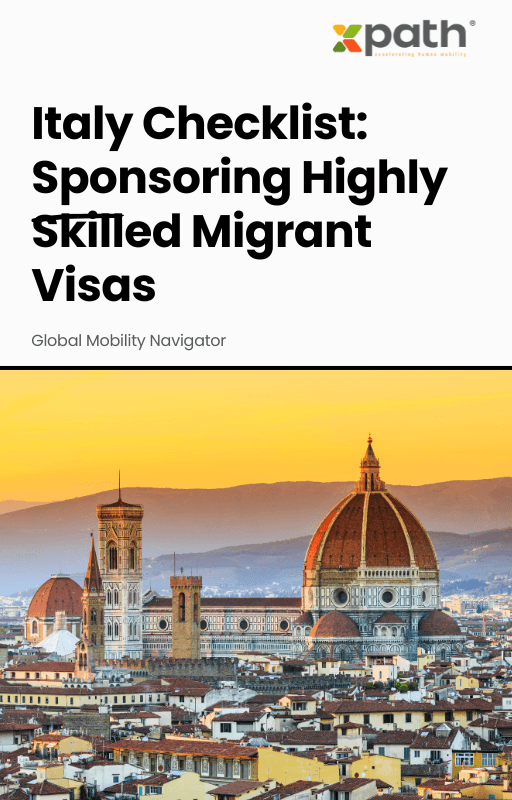Italy Checklist: Sponsoring Highly Skilled Migrant Visas
Grab a copy of a guide to international employee relocation
View E-bookManaging a globally mobile workforce can feel like navigating a ship in tricky waters—there are unfamiliar jurisdictions, unpredictable tides of regulations, and constantly shifting expectations. That’s where the concept of shadow payroll comes in. Ever heard of it? If not, you’re not alone—but if you’re operating across borders, it’s time to pull back the curtain on this crucial global mobility solution. In this article, we’ll break down what shadow payroll is, why it matters, and how organizations like yours can implement it efficiently to stay compliant and hassle-free.
Shadow payroll sounds mysterious, but it’s actually a straightforward concept. Simply put, it’s the practice of running an employee’s payroll in both their home and host countries while they’re on an international assignment. The “shadow” part? The host country’s payroll is maintained for tax compliance and reporting—but without actual salary payments being made through it. Instead, the employee continues to receive their pay from their original country.
This process ensures companies fulfill local tax reporting and withholding requirements—even when the actual compensation comes from abroad. As organizations become more global, shadow payroll helps tie compliance together in a neat bow, making sure nobody, not the employer and not the employee, gets any unwanted tax surprises.
The demand for agile and compliant mobility solutions is surging. According to EY’s 2023 Global Mobility Effectiveness Survey, 77% of global organizations have employees working internationally, with remote and hybrid arrangements playing a huge role post-pandemic. As cross-border moves increase, tax compliance headaches have followed—almost 60% of surveyed organizations stated that tracking and managing tax requirements is their top challenge in mobility.
Additionally, the complexity isn’t just about volume—it’s about variation. Deloitte reported in 2022 that 85% of multinational companies have implemented or are considering shadow payroll as part of their compliance toolkit due to increasing audit attention in host countries. Clearly, shadow payroll isn’t just good practice; it’s fast becoming an industry standard.
Imagine an employee based in France who takes a one-year assignment in Brazil. Instead of transferring all payroll responsibilities to Brazil, the company keeps the main payroll running in France, ensuring the employee’s social security and pension contributions continue uninterrupted. Simultaneously, a “shadow” payroll is created in Brazil, where the employee’s salary and benefits are recorded only for tax withholding and reporting purposes.
This double-layered approach delivers several advantages: it simplifies pay administration for the HR team, preserves employee benefits (like retirement plans) tied to the home country, and—most importantly—it ensures the company remains compliant with tax requirements on both ends. No more worrying about nasty fines or double taxation!
Let’s not sugarcoat it—implementing shadow payroll isn’t always smooth sailing. Companies face hurdles like:
Yet, with the right expertise, technology, and process integration, these issues can be tackled head-on. Enter global mobility solution platforms like xpath.global, which centralize data and automate cross-border payroll management, reducing manual errors and shielding you from costly compliance snafus.
Thinking of launching or improving your shadow payroll measures? Start by mapping assignment locations and relevant tax jurisdictions, then establish clear lines of communication with finance, HR, and external payroll experts. Use a single source of truth—like a digital global mobility platform—to sync data streams, track reporting deadlines, and automate calculations.
Remember, shadow payroll isn’t a set-and-forget solution; regular reviews and tech upgrades are key to staying ahead of regulatory changes. Partnering with a proven mobility solution provider like xpath.global offers a safety net, enabling real-time compliance updates, localized legal advice, and seamless end-to-end payroll management wherever your talent travels.
Navigating the rough waters of global payroll can be daunting, but shadow payroll is the compass you need to steer clear of tax traps and compliance storms. With international assignments on the rise, organizations simply can’t afford to overlook this solution. Ready to bring your payroll compliance up to speed? Don’t go it alone—explore the robust, tech-driven support by platforms like xpath.global and protect your global workforce (and sanity) wherever they land.
1. When should we implement shadow payroll?
Shadow payroll is typically essential whenever an employee is on a long-term assignment in a host country but remains employed and paid from the home country. It helps ensure compliance with host country tax and social security rules.
2. Is shadow payroll the same as paying twice?
No, salaries are not paid twice—the “shadow” payroll is only for compliance and reporting, not for actual payments. The host country records the income and calculates local obligations, while the real salary flows to the employee from the home payroll.
3. Do small companies need shadow payroll?
Absolutely. Even a single international assignment can trigger host country tax requirements. Shadow payroll helps companies of any size avoid unexpected penalties and streamline reporting.
4. Can I automate shadow payroll?
Yes. Many companies now use global mobility management platforms like xpath.global to automate compliance tracking, reduce manual effort, and manage reporting efficiently across multiple jurisdictions.
5. What’s the risk of skipping shadow payroll?
Skipping it can lead to underpaid taxes, fines, reputational damage, and unhappy employees. Regular audits in some countries mean that compliance gaps are increasingly likely to be detected—and penalized.
Ready to transform your mobility program? Explore xpath.global’s solutions.

Italy Checklist: Sponsoring Highly Skilled Migrant Visas
Grab a copy of a guide to international employee relocation
View E-book